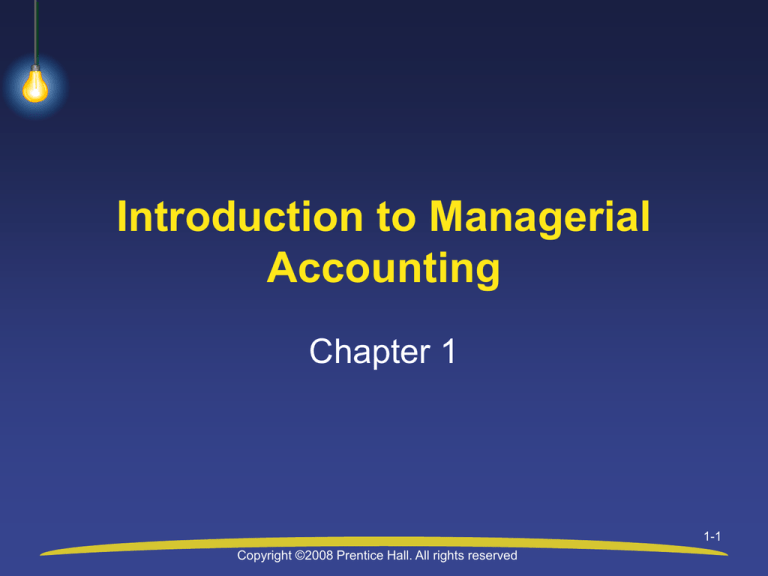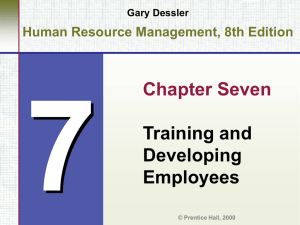
Introduction to Managerial
Accounting
Chapter 1
1-1
Copyright ©2008 Prentice Hall. All rights reserved
Objective 1
Identify managers’ four primary
responsibilities
1-2
Copyright ©2008 Prentice Hall. All rights reserved
Managers’ Responsibilities
Decision
Making
Planning
Setting goals and
objectives
Directing
Overseeing day-today operations
Controlling
Evaluating results
of operations
1-3
Copyright ©2008 Prentice Hall. All rights reserved
Objective 2
Distinguish financial accounting
from managerial accounting
1-4
Copyright ©2008 Prentice Hall. All rights reserved
Managerial vs Financial Accounting
Issue
Managerial
Financial
Primary Users
Internal
External
Purpose of
Information
Plan, Direct,
Users make
Control, Decide investing and
lending
decisions
1-5
Copyright ©2008 Prentice Hall. All rights reserved
Managerial vs Financial Accounting
Issue
Primary
Accounting
Product
What is
included?
Managerial
Financial
Internal Reports General
useful to
Purpose
Management
Financial
Statements
Defined by
Determined by
Management
GAAP
1-6
Copyright ©2008 Prentice Hall. All rights reserved
Managerial vs Financial Accounting
Issue
Managerial
Underlying
Basis of
Information
Internal and
External
Transactions,
focus on future
Emphasis
Data must be
relevant
Financial
Based on
historical
transactions
with external
parties
Data must be
reliable and
objective
1-7
Copyright ©2008 Prentice Hall. All rights reserved
Managerial vs Financial Accounting
Issue
Managerial
Financial
Business Unit
Segments of
the business
Company as a
whole
Preparation
Depends on
management
needs
Internal audit
Annually and
Quarterly
Verification
External audit
1-8
Copyright ©2008 Prentice Hall. All rights reserved
Managerial vs Financial Accounting
Issue
Information
Requirements
Impact on
employee
behavior
Managerial
Financial
No requirement SEC requires
publicly traded
companies to
issue audited
financial
statements
Careful
Adequacy of
consideration
disclosure
1-9
Copyright ©2008 Prentice Hall. All rights reserved
E1-10
What type of
users outside
of the company
might utilize
financial
information?
a. Companies must follow GAAP in their
financial accounting
____________________
systems.
b. Financial accounting develops reports for
external parties, such as __________
and _______________.
c. When managers evaluate the company’s
performance compared to the plan, they
controlling role of
are performing the __________
Management.
1-10
Copyright ©2008 Prentice Hall. All rights reserved
E1-10
d. __________
Managers are decision makers inside
a company.
e. ___________________
Financial accounting provides
information on a company’s past
performance to external parties.
Managerial accounting
f. ______________________
systems are
not restricted by GAAP but are chosen
by comparing the costs versus the
benefits of the system.
1-11
Copyright ©2008 Prentice Hall. All rights reserved
E1-10
g. Choosing goals and the means to
planning function
achieve them is the __________
of management.
h. _____________________
Managerial accounting systems report
on various segments or business units of
the company.
Financial accounting
i. ____________________
statements of
public companies are audited annually by
CPAs.
1-12
Copyright ©2008 Prentice Hall. All rights reserved
Objective 3
Describe organizational structure and the
roles and skills required of management
accountants within the organization
1-13
Copyright ©2008 Prentice Hall. All rights reserved
Organizational Structure
Board of
Directors
Audit
Committee
Chief Executive
Officer
Chief Operating
Officer
Vice Presidents
of various
operations
Chief Financial
Officer
Treasurer
Controller
Internal Audit
1-14
Copyright ©2008 Prentice Hall. All rights reserved
Changing Roles of Management
Accountants
• Ensuring accurate financial records
Helping to design information systems
Recording non-routine transactions
Making adjustments to financial records
• Planning, analyzing, and interpreting
accounting data
• Providing decision support
1-15
Copyright ©2008 Prentice Hall. All rights reserved
Required Skills
• Knowledge of financial and managerial
accounting
• Analytical skills
• Knowledge of how a business functions
• Ability to work on a team
• Oral and written communications skills
1-16
Copyright ©2008 Prentice Hall. All rights reserved
E1-11
a. The _____
CFO and the _____
COO report to the
CEO.
b. The internal audit function reports to the
audit committee
CFO or _______
CEO and the _____________.
c. The __________
is directly responsible for
controller
financial accounting, managerial
accounting, and tax reporting.
Board of Directors
d. The CEO is hired by the______________.
1-17
Copyright ©2008 Prentice Hall. All rights reserved
E1-11
e. The __________
treasurer is directly responsible
Management
for raising capital and investing funds.
accountants
have many skills
f. The __________
is directly responsible
COO
and need to be
for the company’s operations. able to work with
all areas in the
g. Managerial accountants often workcompany.
with
__________________________.
h. The subgroup of the board of directors is
audit committee
called the _________________.
1-18
Copyright ©2008 Prentice Hall. All rights reserved
Objective 4
Describe the role of the Institute of
Management Accountants (IMA) and use
its ethical standards to make reasonable
ethical judgments
1-19
Copyright ©2008 Prentice Hall. All rights reserved
IMA
• Professional association for management
accountants
• Goal
Advance Managerial accounting profession through
•
•
•
•
Certification
Practice Development
Education
Networking
• Certifications
Certified Management Accountant (CMA)
Certified Financial Managers (CFM)
1-20
Copyright ©2008 Prentice Hall. All rights reserved
Summary of Ethical Standards
Management Accountants must comply with Four Ethical Standards
Maintain Professional
COMPETENCE
Uphold INTEGRITY
Preserve
CONFIDENTIALILTY
of Information
Perform Duties with
CREDIBILITY
1-21
Copyright ©2008 Prentice Hall. All rights reserved
Steps to Resolve
Ethical Dilemmas
• Follow company’s policies for reporting
unethical behavior
• If not resolved
Discuss with immediate supervisor
Discuss with objective advisor/IMA Ethics
counselor
Consult an attorney
1-22
Copyright ©2008 Prentice Hall. All rights reserved
E1-13
a. The ______
IMA
is the professional
association for management
accountants.
b. The institute offers two types of
CMA and _____.
CFM
certification – the _____
CMA
c. The __________
exam focuses on
managerial accounting topics,
economics, and business finance.
1-23
Copyright ©2008 Prentice Hall. All rights reserved
E1-13
CFM exam focuses on financial
d. The ______
statement analysis, business valuation,
risk management, working capital policy,
and capital structure.
e. The institute’s monthly publication, called
________________,
addresses current
Strategic Finance
topics of interest to management
accountants.
1-24
Copyright ©2008 Prentice Hall. All rights reserved
E1-13
f. The institute says that approximately
85 percent of accountants work inside
_____
of organizations, rather than at CPA
firms.
1-25
Copyright ©2008 Prentice Hall. All rights reserved
Objective 5
Discuss trends in the business
environment
1-26
Copyright ©2008 Prentice Hall. All rights reserved
CEO and CFO responsible for financial
statements, internal
control system,
procedures for financial
reporting
Audit committee –
independent and
should include a
financial expert
Sarbanes-Oxley Act of 2002
CPA firms – limited
non-audit services for
audit clients and
periodic quality
review
Stiffer penalties for
white-collar crimes
Copyright ©2008 Prentice Hall. All rights reserved
1-27
Current Trends
• Shifting economy
• Competing in global marketplace
• Time-based competition
Advanced Information Systems
E-Commerce
Just-in-Time Management
• Total Quality Management
• ISO Certification
• Cost Benefit Analysis
1-28
Copyright ©2008 Prentice Hall. All rights reserved
Objective 6
Use cost-benefit analysis to make
business decisions
1-29
Copyright ©2008 Prentice Hall. All rights reserved
E1-18
1. What are the total costs of adopting JIT?
Employee training
Streamline production process
Supplier identification
Total costs
$13,500
37,000
8,000
$58,500
1-30
Copyright ©2008 Prentice Hall. All rights reserved
E1-18
2. What are the total benefits of adopting
JIT?
Savings in warehouse expenses $97,000
Lower spoilage costs
46,000
Total benefits
$143,000
1-31
Copyright ©2008 Prentice Hall. All rights reserved
E1-18
3. Should Wild Rides adopt JIT? Why or
why not?
Expected total benefits
Expected total costs
Excess of benefits over costs
$143,000
(58,500)
$ 84,500
Wild Rides should adopt JIT because the
expected benefits exceed the costs.
1-32
Copyright ©2008 Prentice Hall. All rights reserved
End of Chapter 1
1-33
Copyright ©2008 Prentice Hall. All rights reserved






